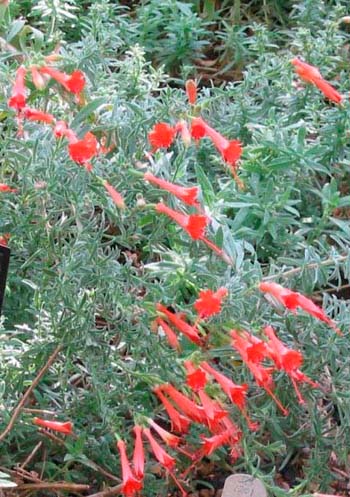 Fire danger is high on Mount Diablo in October -- perhaps because the arch-fiend haunts his namesake peak for the season of All Hallow's Eve, but more likely because the summer months have brought little water, and the parched local plant life must endure the purgatory of autumn while awaiting winter rains. Rocky, striated soil testifies to ancient forces in the bowels of the earth, and sustains today's fire-dependent ecosystem. Such infernal conditions have produced a hardy and drought-tolerant flora in a palette of feverish reds, subtle yellows, and silvery greens. Not only do the native plants of Mount Diablo "care for themselves" in the garden, but they evince an awareness of our history and help to define the identity of our region.
Fire danger is high on Mount Diablo in October -- perhaps because the arch-fiend haunts his namesake peak for the season of All Hallow's Eve, but more likely because the summer months have brought little water, and the parched local plant life must endure the purgatory of autumn while awaiting winter rains. Rocky, striated soil testifies to ancient forces in the bowels of the earth, and sustains today's fire-dependent ecosystem. Such infernal conditions have produced a hardy and drought-tolerant flora in a palette of feverish reds, subtle yellows, and silvery greens. Not only do the native plants of Mount Diablo "care for themselves" in the garden, but they evince an awareness of our history and help to define the identity of our region.
The level of vegetation diversity here reaches nearly as high as the mountain itself. Mount Diablo State Park encompasses 81,000 acres, with countless trails to explore and a litany of evocative place names that read like poetry: Prospector's Gap, Grapevine Spring, Alamo Canyon, Hidden Pond, Black Hawk Ranch, Sycamore Creek, Fossil Ridge, Knobcone Point, and many more. Rich associations between geology and biology give rise to a number of distinct plant communities -- including woodland, chaparral, grassland, and riparian -- a smorgasbord for the casual leaf-peeper and the home horticulturalist, and all within the course of a single day's hike. Insiders recommend Mitchell Canyon (on the north side of the park near Clayton) as the best destination.
Prized for an autumnal bloom attracting hummingbirds, low-growing Epilobium canum (formerly Zauschneria and still known by the common name California Fuchsia) punctuates the dry October landscape with silky bluish-green plumes covered in tubular red flowers. It clings to rocky embankments on the margins of chaparral and spreads by creeping, rarely reaching more than 1 or 2 feet tall. An excellent edging for sunny beds or along the base of walls, this perennial is indispensable in the garden for its brilliant fall color when other plants have gone to seed. Here on Mount Diablo, Epilobium canum grows together with California sagebrush, bush monkeyflower, black sage, and Yerba Santa, all outstanding choices for the California habitat garden.
Another of our most important species for wildlife, Baccharis pilularis or Coyote Brush blooms in October and November with tufts of shaggy blossoms in yellowing shades of white. A glabrous shrub from 5 to 15 feet tall, it grows rich evergreen foliage with a thick mounding habit in which many birds prefer to nest, while its late-season flower provides a crucial source of nectar for beneficial insects in an otherwise hungry time. This vigorous species makes a good filler in the garden, or can serve as background for showier specimens.
Mount Diablo is home to a rare and exquisite endemic species of manzanita: Arctostaphylos auriculata, or the Mount Diablo manzanita, typed on the trail above Boyd Ranch (now the Mount Diablo Country Club). It grows in the chaparral between 4 to 14 feet tall with an elegant serpentine curvature to its branches, long white bristles between its silvery leaves, and a dense white winter bloom. Often difficult to find in the trade, specimens are available in limited quantity from the East Bay chapter of CNPS and from the Strybing Arboretum nursery.
All the undergrowth on Mount Diablo harbors devilish thickets of poison oak (Toxicodendron diversilobium), while the trees beside streams, near springs, and along canyons are draped in thick vines of California wild grape (Vitis californica). Both these species produce spectacular red foliage before dropping their leaves in winter. The latter gives insignificant fruit but grows voraciously and looks wonderful in the fall, a real treat on a trellis or against a wall; the former is tricky, unsuitable in the garden except for witches seeking a good garnish for eye of newt and toe of frog.
The name Mount Diablo itself derives from a thicket, though swathed in mystery and misunderstanding. On a Spanish map from 1824, "Monte del Diablo" signifies a Christian Indian village, not a mountain. The reference comes from an expedition of Conquistadors hunting runaway mission Indians at the turn of the 19th century. At dusk by a willow thicket near present-day Buchanan Field, the soldiers stumbled upon a group of recalcitrant Chupcan Indians who refused to abandon their ancestral ways in favor of the Spanish missions. The Conquistadors surrounded the site, intending to capture the Chupcans at sunrise, but that night all the Indians escaped. Angry and confused, the Spanish called the site Monte del Diablo or "Thicket of the Devil." Later, English-speaking newcomers took monte to mean "mountain" and erroneously applied the title to this prominent East Bay summit.
By any other name, Mount Diablo stands among the Bay Area's most valuable ecological treasures. Take a peek into the recently revised Flowering Plants and Ferns of Mount Diablo by Ertter and Bowerman, two of California's most respected minds in botany. A dynamo in her early 90s, Mary Bowerman plays an active role in Save Mount Diablo, the preservation movement she founded 32 years ago, and prowls the mountain for new plants whenever the opportunity arises. (Willis Jepson, whose eponymous Manual sets the standard for California flora, called Bowerman's original 1944 flora of Mt. Diablo "a book always to have and to hold.") Native plant enthusiasts are raving about the latest edition of Bowerman's work, updated in 2002 by Barbara Ertter.
You can find further information through the state park service, the Mount Diablo Interpretive Association, and Save Mount Diablo, but there's no substitute for experiencing the mountain first-hand. You native plant fanciers, you trick-or-treaters, take up the torch and come for a walk with the devil.
# # #
Geoffrey Coffey is going for Halloween this year dressed as Toxicodendron diversilobium. He is the founder of Madroño landscape design studio, a princpal of Bay Natives nursery, and a freelance writer for the San Francisco Chronicle.

